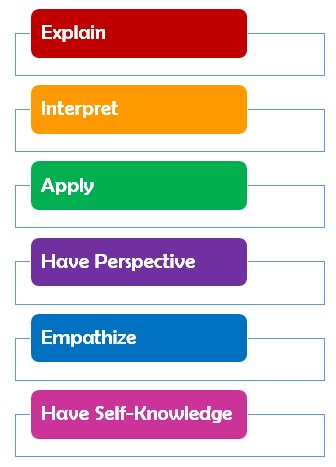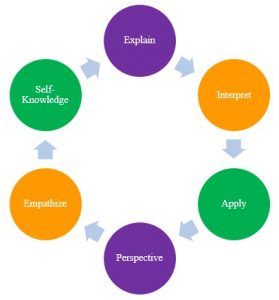Six Facets of Understanding
In their book, Understanding by Design (1998), Grant Wiggins and Jay McTighe discuss “Six Facets of Understanding.” These six facets of understanding help instructional designers determine if students have a deep understanding of the idea or concept that is being taught. The authors provide a framework for instructional designers that systematically addresses the six levels of understanding.
Wiggins and McTighe suggest that when a person truly understands, they…
- Can explain
- Can interpret
- Can apply
- Have perspective
- Can empathize
- Have self?knowledge
Demonstrating Understanding
The six facets of understanding are a way of confirming students truly understand what they have been taught. The six facets represent different ways of demonstrating understanding. If students do any of the six facets, they are demonstrating a level or degree of understanding.
There are different degrees of understanding. Understanding can be deepened or furthered by questions that arise from reflection, discussion, and application of ideas. A complete and mature understanding ideally involves the full development of all six kinds of understanding.
Six Facets of Understanding
Explain
At this first level, students can provide sophisticated explanations or theories to expand upon events, actions, and ideas. They are able to provide thorough and justifiable accounts of phenomena, facts, and data.
Interpret
At this level, students can identify meaning in what they have learned through interpretations, narratives, and translations. They are able to relate it to their life and things happening around them. They are able to tell meaningful stories, offer apt translations, provide a revealing historical or personal dimension to ideas and events. Furthermore, they can make it personal or accessible through images, anecdotes, analogies, and models.
Apply
At this level, students can demonstrate the ability to effectively adapt what they have learned by using knowledge in new situations and contexts. They are able to take what they know and use it in everyday life.
Have perspective
At this level, students can identify a variety of critical and insightful points of view. They are able to see and hear viewpoints through critical eyes and ears, and understand something from more than their own perspective. They are also able to see the big picture.
Empathize
At this level, students demonstrate an ability to get inside another person’s feelings. They are able to find value in what others might find odd, alien, or implausible. They can perceive sensitively on the basis of prior indirect experience.
Have self-knowledge
At this final level, students demonstrate a wisdom in knowing their personal style, prejudices, projections, and habits of mind both shape and impede our own understanding. They are aware of what they do not understand and why understanding is so hard. They are able to see the difference between their perspective and others.
Related Links
Taxonomy of Significant Learning
References
Understanding by Design (1998), Grant Wiggins and Jay McTighe



